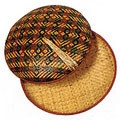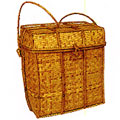Throughout Bhutan, cane and bamboo products have always complemented wood as the most commonly used material to produce items of everyday use. Cane and bamboo have been made into storage containers, baskets for carrying food, utensils, musical instruments, bows and arrows, walls for houses, fences, ropes, and floor mats. The abundant and lush forests in the Himalayan foothills provide the raw material. Over a hundred varieties of cane and bamboo plants thrive in the rain fed forests and are often combined with hard and soft wood from the oak, cedar, maple walnut, and other varieties of wood.
The bamboo or rattan is cut into thin strips, braided, and coloured to form geometric designs; sometimes the natural colouring is left as is. The colours used include yellow, green, natural brown-green, blue-purple, and maroon.
RAW MATERIALS
Bamboo is a tall perennial grass found in the tropical and subtropical regions of the world. The bamboo family has over 700 species and each species has its own characteristics. Broadly speaking, the stems of a bamboo plant called culms are cylindrical, woody, and jointed. Most species have hollow stems. Not only is there a large variation in the size and the quality of the stems of different species, but also in that of the same species, depending on where it grows. Stems may be large and hollow when grown in moist, fertile climates and small and solid in dry and sandy soils. The plant has the ability to withstand dry as well as cold climates. Some species grow as high as 3,000 meters.
Bamboo culms are cylindrical stems, which stand tall, and taper at the top; the maximum diameter is at the base. They are thus hollow cylinders, regularly divided by transverse walls at nodes, which appear as a slight swelling on the surface of the cylinder. Bamboo shoots grow the maximum during the monsoon months and take 6 to 12 years to grow into mature culms.

Cane or rattans are long slender stems of certain trailing or climbing palms. Some stems are erect but most are typically trailing or climbing. They may be up to 200 meters or more in length. They require constant and abundant water for optimum development. Canes are usually cylindrical and of uniform thickness. They are solid, straw yellow to brown in colour, and are more or less covered by spiny leaf sheaths. The core of the stems is soft and spongy, and made of coarse fibres. The surface is hard, smooth, and shiny due to a deposit of silica.
Cane has been exploited for its properties of toughness, strength, flexibility, and elasticity. It requires a warm moist atmosphere and abundant watering. The growth of is slow for the first few years: often the cane take 15 years to come into full bearing – thereafter it can be harvested every two to three years.
PRACTITIONERS & LOCATIONS
Bamboo is one of the most commonly used raw materials in crafts; it also represents the most widespread skill in the traditional cottage industry. Bamboo and cane or rattan wares are mostly made by peasants in the areas around the old region of Kheng of central Bhutan. Both men and women do the weaving and produce splendid bamboo and rattan work. Other areas where cane and bamboo work is done are Khangpara in Trashigang district in eastern Bhutan and in the Shimgaong District of southern Bhutan.
PROCESS & TECHNIQUES
Bamboo is known for its combination of tensile strength and durability, and its lightness, created because of the hollow inter-nodes. Bamboo is used whole or split and then used. Depending on the required quality and durability of the product being, bamboo is used untreated or else treated before use to preserve it from insects and fungus.
The best season for harvesting cane is from November to March. This has to be done carefully to avoid damage to the clumps. Mature stems are cut at the base and pulled by hand from their lofty perches on the crowns of supporting trees. The soft terminal portion of the stem is discarded. The sheaths are removed with a knife or by dragging them against the barks of trees. The stems are cut to standard lengths and dried in the sun. If the weather is wet the drying is done near a fire. If the stems are not properly dried soon after harvesting they deteriorate very quickly.

In order to get good quality raw material (good colour, smooth, flexible, and durable) it is essential to process the cane properly after harvesting. Cane is dried and then split vertically and cut to standard lengths. To obtain the fine creamy colour that characterises cane, the cane is often fumigated in sulphur – this also provides some protection against insects. The cane is then polished to restore lost lustre. Some varieties of cane are treated by smoking over a fire and then polishing them with coconut oil. Cane strips are often coloured to form geometric designs. The dyeing of cane and bamboo in order to make colourful products was adopted in the 1970s. Traditional colours include yellow, green, natural, blue-purple, or maroon and are both natural and chemical in nature.
Cane and bamboo are then fashioned into objects, often in combination with each other or with various woods.
PRODUCT RANGE
A wide variety of bamboo and cane articles are made in the country, especially in the Kheng district of central Bhutan. They include hats (belo), baskets (pangchu), wine caskets (palang), mats, butter containers, bows and arrows, arrow sheaths, etc. The most popular item is bamboo baskets used for carrying food – these are round, almost airtight, and brightly coloured.
The baskets are woven from very finely split cane; some of the lengths are coloured to form a pattern. They are made in two pieces that fit closely enough to enable water to be carried in them. The baskets range from 6 to 15 inches in diameter, and the Bhutanese use them principally to carry cooked rice and food. They also make much larger and stronger baskets, very much in the shape of a mule-pannier, and these are used in a similar way for pack-animals.

- Tsezem: Basket
These baskets are used to store dried meat and carry all kinds of food and articles and often used as shopping bags. - Lakchung: Basket
Traditionally used as a fruit container and for serving dry food items on special occasions and ceremonies. This basket is multi-purpose and is often used as a waste-paper basket or a flower vase. - Beykhur: Gift Box
This basket has a square shape and is traditionally used for storage of yarns. - Bello: Hat
The bello is used by farmersto protect themselves from sun and rain. - Bangchu:Round Bamboo Plate
The Bangchu is traditionally used as a rice plate and for carrying pack-lunches. Also used as a container for serving snacks. - Poe: Incense Sticks
Incense sticks are used daily as offerings to Buddhas, Bodhisattvas, and protective deities and celestial beings. Zurpoe is a Special Incense prepared according to ancient traditions using a blend of more than one hundred precious aromatic and medicinal substances like nagi (scale of Pangolin), musk, red and white sandalwood, giwang (Bezoar), clove, nutmeg, saffron etc… - Poe Palang: Incense Container
These are used for storing incense sticks (poe) in dzongs, monasteries, and households all over the country. - Jatsa:
Sieves made of plain bamboo areTea Strainer traditionally used for straining butter-tea and milk in Bhutanese households. - Sipa: Butter & Cheese Container
Made of wood and bamboo, these containers were traditionally used to hold butter and cheese. It is ususally either round or oval in shape. - Palang: Alcohol and Water Container
Made of bamboo – they are traditionally used to store and serve alcohol and water. - Zhu: Bow & Dha: Arrows
The Bhutanese arrow (dha) is made of bamboo with a feather-head and metal point.The Bhutanese bow (zhu) is made from a bamboo species prevalent in the foothills of Bhutan. The best bamboo is found in the villages of Taba and Damtey in Samtse. - Soray Palang: Quiver
Traditionally the quiver is made of wood and bamboo. - Dala
Is used for dehusking rice. - Mats
Finely woven mats are a common and popular craft item. Split cane is used in its natural colour or dyed to form patterns. Mats can be found in almost any size up to about 16 square feet.
Gallery
YOUR VIEWS
PRACTITIONERS: INDIA
Access 70,000+ practitioners in 2500+ crafts across India.
BIBLIOGRAPHY
10,000+ listings on arts, crafts, design, heritage, culture etc.
GLOSSARY
Rich and often unfamiliar vocabulary of crafts and textiles.
SHOP at India InCH
Needs to be written.






